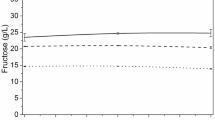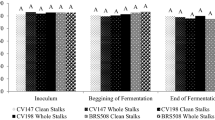Abstract
The formation of volatile by-products during alcoholic fermentation is affected by many factors such as the type of yeast strain applied, technological parameters of the process and the raw material used as the main constituent of the fermentation medium. The influence of availability of sugars released by the plant polysaccharide hydrolysis on the concentration of higher alcohols during the fermentation process was analyzed. Significant differences in the starch hydrolysis dynamics for various raw materials, entailing changes in availability of sugars such as glucose, maltose, maltotriose and maltotetraose, are reported. The highest glucose concentration after the mashing process (93.8 ± 3.8 mg cm−3) was observed for the maize mash (as compared to that of the rye and amaranth mashes, 24.9 ± 0.9 and 46.9 ± 2.5 mg cm−3, respectively). The highest glucose content in the maize mash resulted in a significantly higher isobutanol and 2-methyl-1-butanol content at the initial stage of fermentation, irrespective of the yeast strain used (D-2 or As-4). The highest final total content of fusel alcohols (ca. 5,460 mg dm−3 EtOH, on average) was also found in the distillates produced from the maize mash. However, the concentration of higher alcohols in the rye and amaranth distillates was similar and reached the level of ca. 3,440 mg dm−3 EtOH, on average. It is shown that the polysaccharide hydrolysis rate, and hence the rate at which fermenting sugars are released, significantly affects the concentration of higher alcohols in the produced distillates.





Similar content being viewed by others
References
Roehr M (2001) Biotechnology of ethanol. Wiley-VCH Verlag GmbH, Weinheim
Borneo R, Aguirre A (2008) Chemical composition, cooking cereals, and consumer acceptance of pasta made with dried amaranth leaves flour. LWT Food Sci Technol 41:1748–1751
Sala M, Berardi S, Bondioli P (1998) Amaranth seed: the potentialities. Riv It Sostanze Grasse 75(11):503–506 (in Italy)
Singhal RS, Kulkarni PR (1990) Studies on applicability of Amaranthus paniculatus (Rajgeera) starch for custard preparation. Starch 42(3):102–103
Dobrzeniecka A, Haberowa H, Sobczak E (1996) The comparison of the quality of ethanol obtain from rye, triticale, amaranths. Przemysł Fermentacyjny i Owocowo-Warzywny 3:12–13 (in Polish)
Kłosowski G, Czupryński B, Kotarska K, Wolska M (2002) Studies on application of Amaranthus grain in agricultural distilleries using pressureless liberation of starch (PLS) technology. Kvasnỳ Prŭmysl 11–12:302–308
Torrea D, Fraile P, Grade T, Ancin C (2003) Production of volatile compounds in the fermentation of chardonnay musts inoculated with two strains of Saccharomyces cerevisiae with different nitrogen demands. Food Control 14:565–571
Lilly M, Bauer FF, Styger G, Lambrechts MG, Pretorius IS (2006) The effect of increased branched-chain amino acid transaminase activity in yeast on the production of higher alcohols and on the flavor profiles of wine and distillates. FEMS Yeast Res 6:726–746
Erten H (2002) Relations between elevated temperatures and fermentation behavior of Kloeckera apiculata and Saccharomyces cerevisiae associated with winemaking in mixed cultures. World J Microb Biot 18:373–378
Lachenmeier DW, Haupt S, Schulz K (2008) Defining maximum levels of higher alcohols in alcoholic beverages and surrogate alcohol products. Regul Toxicol Pharm 50:313–321
Hazelwood LA, Daran J-M, van Maris AJA, Pronk JT, Dickinson R (2008) The Ehrlich pathway for fusel alcohol production: a century of research on Saccharomyces cerevisiae metabolism. Appl Environ Microb 74(8):2259–2266
Valero E, Moyano L, Millan MC, Medina M, Ortega JM (2002) Higher alcohols and esters production by Saccharomyces cerevisiae. Influence of the initial oxygenation of the grape must. Food Chem 78(1):57–61
Procopio S, Krause D, Hofmann T, Becker T (2013) Significant amino acids in aroma compound profiling during yeast fermentation analyzed by PLS regression. LWT Food Sci Technol 51:423–432
Muñoz D, Peinado RA, Medina M, Moreno J (2006) Higher alcohols concentration and its relation with the biological aging evolution. Eur Food Res Technol 222:629–635
Schehl B, Muller C, Senn T, Heinisch JJ (2004) A laboratory yeast strain suitable for spirit production. Yeast 21:1375–1389
Mallouchos A, Komaitis M, Koutinas A, Kanellaki M (2003) Wine fermentations by immobilized and free cells at different temperatures. Effect of immobilization and temperature on volatile by-products. Food Chem 80:109–113
Fleet GH, Hears GM (1993) Yeast: growth fermentation. In: Wine microbiology and biotechnology. Harwood Academic Publishers, Chur
Ehrlich F (1907) Über die Bedingungen der Fuselölbildung und über ihren Zusammenhang mit dem Eiweissaufbau der Hefe. Berichte Deutsch Chem Gesellschaft 40:1027–1047
Moreno-Arribas MV, Polo MC (2009) Wine chemistry and biochemistry. Springer Science + Business Media, New York
Perez-Carrillo E, Serna-Saldivar SO, Chuck-Hernadez C, Cortez-Callejas ML (2012) Addition of protease during starch liquefaction affects free amino nitrogen—fusel alcohols and ethanol production of fermented maize and whole and decorticated sorghum mashes. Biochem Eng 67:1–9
Oshita K, Kubota M, Uchida M, Ono M (1995) Clarification of the relationship between fusel alcohol formation and amino acid assimilation by brewing yeast using 13C—labeled amino acid. In: Proceedings European brewing convention, Brussels, pp 387–394
Lambrechts MG, Pretorius IS (2000) Yeast and its importance to wine aroma—a review. S Afr J Enol Vitic 21:97–129
Ribéreau-Gayon P, Dubourdieu D, Donèche B, Lonvaud A (2006) Handbook of enology, vol 1. The microbiology of wine and vinifications, 2nd edn. Wiley, England
Reazin G, Scales H, Anderson AA (1970) Mechanism of major congener formation in alcoholic grain fermentations. J Agric Food Chem 18:585–589
Cachot T, Müller M, Pons M-N (1991) Kinetics of volatile metabolites during alcoholic fermentation of cane molasses by Saccharomyces cerevisiae. Appl Microbiol Biotechnol 35:450–454
Engan S (1972) Wort composition and beer flavor. II. The influence of different carbohydrates on the formation of some flavor components during fermentation. J Inst Brew 78:169–173
Kruger L, Pickerell ATW, Axcell B (1992) The sensitivity of different brewing yeast strains to carbon dioxide inhibition: fermentation and production of flavor-active volatile compounds. J Inst Brew 98:133–138
Singh R, Kunkee RE (1976) Alcohol dehydrogenase activities of wine yeast in relation to higher alcohol formation. Appl Environ Microb 32(5):666–670
BS EN ISO 10520:1998. Native starch. Determination of starch content. Ewers polarimetric method, ISBN: 0 580 30395 0
Kłosowski G, Czupryński B (2006) Kinetics of acetals and esters formation during alcoholic fermentation of various starchy raw materials with application of yeast Saccharomyces cerevisiae. J Food Eng 72:242–246
Kłosowski G, Mikulski D (2010) The effect of raw material contamination with mycotoxins on the composition of alcoholic fermentation volatile by-products in raw spirits. Bioresource Technol 101:9723–9727
Kłosowski G, Czupryński B, Wolska M (2006) Characteristics of alcoholic fermentation with the application of Saccharomyce cerevisiae yeasts: As-4 strain and I-7-43 fusant with amylolytic properties. J Food Eng 76:500–505
Alfenore S, Molina-Jouve C, Guillouet SE, Uribelarrea J-L, Goma G, Benbadis L (2002) Improving ethanol production and viability of Saccharomyces cerevisiae by a vitamin feeding strategy during fed-batch process. Appl Microbiol Biotechnol 60:67–72
Dietvorst J, Londesborough J, Steensma HY (2005) Maltotriose utilization in lager yeast strains: MTT1 encodes a maltotriose transporter. Yeast 22:775–788
D’Amore T, Russell I, Stewart GG (1989) Sugar utilization by yeast during fermentation. J Ind Microbiol 4:315–324
Okunowo WO, Okotore RO, Osuntoki AA (2005) The alcoholic fermentative efficiency of indigenous yeast strains of different origin on orange juice. Afr J Biotechnol 4:1290–1296
Mateo JJ, Jiménez M, Pastor A, Huerta T (1998) Influence of the inoculation time of high sugar content must on the formation of wine aroma. World J Microb Biot 14:357–363
Pinal L, Cedeño M, Gutiérrez H, Alvarez-Jacobs J (1997) Fermentation parameters influencing higher alcohol production in the tequila process. Biotechnol Lett 19(1):45–47
Acknowledgments
The authors want to thank Professor Bogdan Sieliwanowicz for his help in the HPLC analysis of saccharides.
Conflict of interest
None.
Compliance with Ethics Requirements
This article does not contain any studies with human or animal subjects.
Author information
Authors and Affiliations
Corresponding author
Rights and permissions
About this article
Cite this article
Kłosowski, G., Mikulski, D., Macko, D. et al. Influence of various yeast strains and selected starchy raw materials on production of higher alcohols during the alcoholic fermentation process. Eur Food Res Technol 240, 233–242 (2015). https://doi.org/10.1007/s00217-014-2323-8
Received:
Revised:
Accepted:
Published:
Issue Date:
DOI: https://doi.org/10.1007/s00217-014-2323-8




